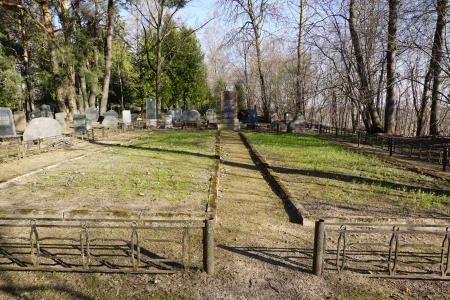Obj. ID: 44163
Jewish Funerary Art Monument at the Mass Grave in the New (Asote) Jewish Cemetery in Krustpils, Latvia, 1959
To the main object: New (Asote) Jewish Cemetery in Krustpils, Latvia

Memorial Name
No official name
Who is Commemorated?
Jewish victims of the Holocaust from Krustpils and Gostiņi (part of the town of Pļaviņas from 1956), murdered in the Kaķīši swamps
Description:
The monument stands at the edge of two large mass graves surrounded by a low metal fence.
The monument is a red granite stele on a gray granite pedestal and a concrete base. From behind, it is supported by concrete “steps.” The stele bears almost identical inscriptions in Russian and Yiddish.
Inscription
Russian
Вечная память
погибшему
еврейскому населению
гор. Крустпилс
и Плявиняс
расстреленному [расстрелянному]
немецкими оккупантами
в 1941 году
Translation: Eternal memory to the perished Jewish population of the towns of Krustpils and Pļaviņas, shot down by German occupiers in 1941.
Yiddish
אייביקער אנדענקונג
די אומגעקומענע אידישע באפעלקערונג
פון קרוסטפילס אונד פליאווינאס
וועלכע זיינען דערשאסן געווארן פון די דייטשע
אקופאנטן אין יאר 1941 ת'נ'צ'ב'ה'
Translation: Eternal memory to the perished Jewish population of the towns of Krustpils and Pļaviņas, who were shot down by German occupiers in 1941. May their souls be bound in the bundle of life.
Commissioned by
Surviving Jews from Krustpils and Gostiņi (part of the town of Pļaviņas from 1956).
sub-set tree:
At the beginning of July 1941, the Krustpils Jews were arrested and driven into the slaughterhouse. Several days later, part of the Jews were taken to the Krustpils Sugar Factory on the outskirts of the town and to Jaunā muiža (approximately 4 km from Krustpils), and the remaining Jews were brought to the premises of the former Jewish School in Krustpils (182 Rīgas Street), where a provisional ghetto was established. On August 1, 1941, all Jews were driven to the former shooting range of the Latgale Artillery Regiment of the Latvian Army in Kaķīši swamp (5–6 km from Krustpils) and murdered there by the Latvian “Arājs Commando” from Rīga, together with local “self–defenders” and policemen. About 250 Jews brought from Gostiņi (part of the town of Pļaviņas from 1956) were mixed with the Krustpils Jews and also shot dead. Apparently, some Jews from western Europe were murdered at the same place in 1942.
The reburial of the Jews murdered in the Kaķīši swamps took place in 1958. The monument on the mass grave was erected in 1959. Photographs of the reburial ceremony in 1958, the unveiling of the monument in 1959, and a commemorative event in 1966 were published by Meyer Meler (2010, p. 224; 2013, p. 190), and a photograph of the unveiling of the monument in 1959 - by Josif Rochko (p. 49) and by Ilya Lensky (Lenskis, p. 44). The Russian inscription on the monument is almost identical to the inscription on the monument in Balvi (see here).
Six Jews from the Leibovich family worked for a week at the Daukstes farm in late July 1941 and were shot not far from the farm. In 1960, an eyewitness Balame showed their grave to Rosenberg, who unearthed the remains and reburied them in the Asote Jewish cemetery (Meler 2010, p. 222; Meler 2013, pp. 188-189).
Lenskis, Ilja, Holokausta piemina Latvijā laika gaitā 1945–2015 = Holocaust Commemoration in Latvia in the Course of Time, 1945–2015 (Riga: Muzejs “Ebreju Latvija,” 2017), p. 44.
Meler, Meyer, Ebreju Kapsētas Latvijā - Jewish Cemeteries in Latvia - Evreiskie kladbishcha v Latvii (Riga: Shamir, 2006)., pp. 56-58.
Meler, Meyer, Jewish Latvia: Sites to Remember (Tel-Aviv: Association of Latvian and Estonian Jews in Israel, 2013), pp. 184-191, 113-114.
Meler, Meyer, Mesta nashei pamiati: Evreiskie obshchiny Latvii, unichtozhennye v Kholokoste (Riga: by the author, 2010), pp. 217-225, 118-119.
Rochko, Josif, Jewish Latgale: Guidebook (Daugavpils, by the author, 2018), pp. 48-49.








